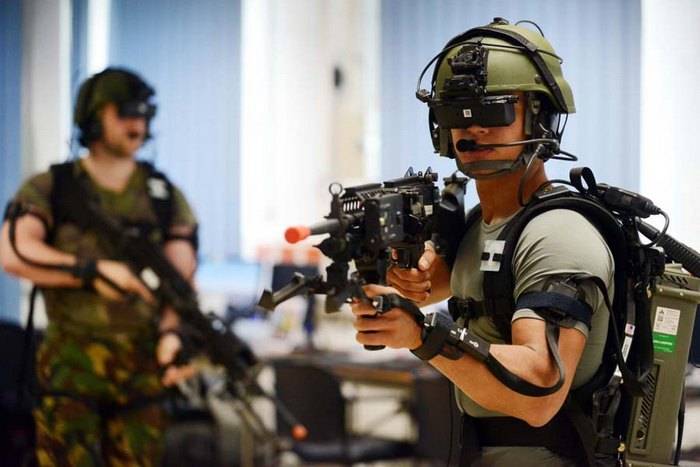Machine Learning to Revolutionize Military Training

Normally sluggish to adapt, the military is taking swift action to utilize cunning edge tech in combat training
Throughout history the lion’s share of soldiers’ schooling has been spent honing their craft against both peers and inanimate targets. Machine learning is prepared to disrupt this status quo and drastically alter the way troops prepare for combat. AI will use machine learning to create custom simulated training scenarios for soldiers that are more dynamic and responsive than what is possible in the real world. Data collected from many iterations of these simulations will be able to provide analytics that the military can use to then refine battlefield tactics for real-life operations and in turn be tested again in a virtual reality trainer. This feedback loop of information will offer new ways to refine strategies and find best practices in a way never before possible. Programs will identify patterns in a soldier’s actions and employ machine learning to adapt the behavior of opposing non-player characters in real time. Currently, the synthetic training simulations in use rely solely on input from subject matter experts to program the actions of the virtual opponents, but that is soon to change.
As of late, the military has been relying on simulations lacking machine learning to augment troop training and test the overall efficacy of virtual reality. The results have been promising thus far as the Department of Defense recently awarded Lockheed Martin a $356 million contract in August 2018 to improve the Close Combat Tactical Trainer (CCTT)- a virtual reality trainer consisting of multiple rooms with 360 degree interactive screens.[1] More importantly however, the Defense Advanced Research Project Agency (DARPA)- an agency of the Department of Defense, has recently announced a $2 billion dollar multi-year campaign to expand the frontier of AI innovation and machine learning.[2] In the words of the agency director Dr. Walker, “We want to explore how machines can acquire human-like communication and reasoning capabilities, with the ability to recognize new situations and environments and adapt to them.”[3] These capabilities would use machine learning to infuse tools like the CCTT with smarter and more adaptable training simulations that improve autonomously.
In July 2018, DARPA also announced its Artificial Intelligence Exploration program. In order to fast track innovation in artificial intelligence and machine learning, the program offers up to $1 million in funding to individuals who present a qualified proposal.[4] The individuals are then required to establish the feasibility of their idea within 18 months. This initiative enables the U.S. government to source and implement innovative ideas on a much faster timeline than what is standard for the public sector.
In the even longer term, the military hopes to expand the application of machine learning beyond utilization as a mere training tool. It plans to integrate machines with human warfighters in the form of artificial intelligence that can predict enemy action based on historical data and a current set of circumstances. This integration will augment troops’ decision making at every level and provide the soldier real time analytics with the statistically optimal best course of action.[2]
The DoD and DARPA should continue to allocate as many resources as possible to improve machine learning due to the incalculably high cost an unprepared defense could incur. The U.S. military enjoys a competitive advantage against all other sovereign nations for now, but considering blistering pace of technological advancement, these countries could make up the difference in a short matter of years. The ability to compile and analyze big data from war game simulations across the military will improve the throughput time of tactical adaptation one hundred-fold. Presently, it takes years from the initial formulation of a new strategy to its dissemination throughout the military. Machine learning can reduce this to a matter of weeks. Noting that the FY 2019 defense budget is $686 billion, the DoD has only allocated a fractional amount of that to machine learning, and would do well to consider the tremendous upside of such programs.[5]
The merits of virtual training must be weighed against the necessary funding required and the future relevance of combat training. Is it prudent to invest such vast amounts of capital in simulated training and machine learning when similar projects are already underway in the private sector? Finally, how important is the proficiency of U.S. troops when future conflicts are becoming less likely to be decided by actual combat but instead by the battle for information?
[717 words]
References
[1] Zack’s Equity Research, “Lockheed Martin Wins 356m Deal For Modernizing CCTT Module,” August 22, 2018, https://www.nasdaq.com/article/lockheed-martin-wins-356m-deal-for-modernizing-cctt-module-cm1011412, accessed November 2018.
[2]”AI Next Campaign,” https://www.darpa.mil/work-with-us/ai-next-campaign, accessed November 2018.
[3]”DARPA Announces 2 Billion Dollar Campaign to Develop Next Wave of AI Technologies,” September 2018 https://www.darpa.mil/news-events/2018-09-07, accessed November 2018.
[4]”Accelerating the Exploration of Promising Artificial Intelligence Concepts,” July 2018, https://www.darpa.mil/news-events/2018-07-20a, accessed November 2018.
[5] Mark Cancian, “Industry Bets On The Defense Budget,” Forbes, October 4, 2018, https://www.forbes.com/sites/markcancian/2018/10/04/industry-should-hedge-its-bets-on-the-defense-budget/#4dfb9aac3965, accessed November 2018.





While I agree with the significant value-add that virtual training can potentially bring to our troops, I believe that the scope of DoD investments should be limited. As you point out, modern warfare is increasingly shifting away from troop deployment and rather towards hacking, drones, latest-generation machinery such as fighter jets and nuclear submarines, etc. A majority of the $686B defense spending specifically goes towards this last item, which seems to be a strategically reasonable allocation. In addition, crucial qualities such as discipline, mental fortitude, and teamwork are forged much more effectively at conventional bootcamps and training bases. Thus, I believe that virtual training could be a reasonable program to pilot on a limited scale with select special force squads such as the SEALs and the Green Beret.